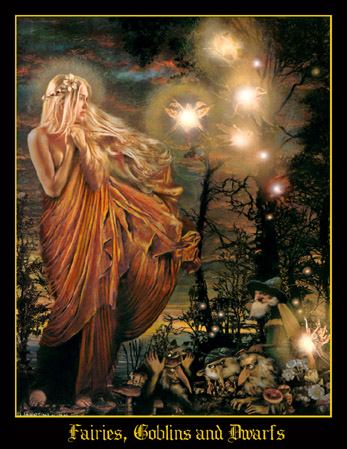



Do you believe in fairies?
by Diane Maclean
If you had asked your great-great-grandmother if she believed in fairies, she would have looked at you askance. Believe in fairies? Of course she did!
Ninety-five per cent of Scots continued to believe in fairies right up until the middle of the 19th century. These were not the diminutive, be-winged fairies of 1800s children's books. No, these were strange folk who bewitched you, killed your cattle and kidnapped your wives and daughters.
Click for Slide Show
Fairy lore flowed through the centuries, their presence acknowledged in ballads, poems and stories. They came in all shapes and sizes and different parts of Scotland had different myths. Even today they are remembered in the fairy glens and fairy hills found in every part of Scotland.
This belief in fairies extended beyond Scotland; there was almost universal acknowledgement that they existed.
There's no question that they existed. We have two fairy houses quite close by and we have records of conversations between fairies and people on the island.
-- Sir Iain Noble
"Fairy folklore was world-wide," says Dr Lizanne Henderson, a lecturer of history at the University of Glasgow's Crichton Campus. "They filled a need to explain the unexplainable. It was easier to look for a rational explanation for things that happened, and back then fairies were the rational explanation."
Yet for all that was written on the subject, there was no consensus about what the fairies were. Earlier writings speak of them as being dead souls or fallen angels. When a more "rational explanation" was needed, there was a move away from describing fairies as mystical and an attempt to place them within the human world.
John Frances Campbell of Islay was one of the first to go into print with his new theory. "I believe there once was a small race of people in these islands," he wrote in 1860.
Campbell’s theory remained speculative until a remarkable archaeological discovery in 2004 on the Indonesian island of Flores. The skeletal remains of a dwarf man, similar to modern humans, were discovered in a cave. Carbon dating proved that this small humanoid co-existed with modern man and may have survived until fairly recently. In light of this discovery, Indonesian folk tales of "little people" are being re-evaluated and questions are being asked if these abnormally small people have been living with us all along.
"I think it's highly unlikely," says Michael Bird, a geo-scientist and professor at St Andrews University who was involved in carbon dating the skull in Indonesia. "Although it's good for funding to let people speculate that they were around for a long time, I think it is probable that modern human ate them just as soon as they landed on the islands."
Monday, February 15, 2010
Posted by ..(@_@)cUtIE l0tZZ(@_@)... at 4:06 PM 0 comments
Tuesday, February 9, 2010
Why does the sky is blue?
?
The white light from the sun is a mixture of all colours of the rainbow. This was demonstrated by Isaac Newton, who used a prism to separate the different colours and so form a spectrum. The colours of light are distinguished by their different wavelengths. The visible part of the spectrum ranges from red light with a wavelength of about 720 nm, to violet with a wavelength of about 380 nm, with orange, yellow, green, blue and indigo between. The three different types of colour receptors in the retina of the human eye respond most strongly to red, green and blue wavelengths, giving us our colour vision.
Tyndall Effect
The first steps towards correctly explaining the colour of the sky were taken by John Tyndall in 1859. He discovered that when light passes through a clear fluid holding small particles in suspension, the shorter blue wavelengths are scattered more strongly than the red. This can be demonstrated by shining a beam of white light through a tank of water with a little milk or soap mixed in. From the side, the beam can be seen by the blue light it scatters; but the light seen directly from the end is reddened after it has passed through the tank. The scattered light can also be shown to be polarised using a filter of polarised light, just as the sky appears a deeper blue through polaroid sun glasses.
This is most correctly called the Tyndall effect, but it is more commonly known to physicists as Rayleigh scattering--after Lord Rayleigh, who studied it in more detail a few years later. He showed that the amount of light scattered is inversely proportional to the fourth power of wavelength for sufficiently small particles. It follows that blue light is scattered more than red light by a factor of (700/400)4 ~= 10.
Dust or Molecules?
Tyndall and Rayleigh thought that the blue colour of the sky must be due to small particles of dust and droplets of water vapour in the atmosphere. Even today, people sometimes incorrectly say that this is the case. Later scientists realised that if this were true, there would be more variation of sky colour with humidity or haze conditions than was actually observed, so they supposed correctly that the molecules of oxygen and nitrogen in the air are sufficient to account for the scattering. The case was finally settled by Einstein in 1911, who calculated the detailed formula for the scattering of light from molecules; and this was found to be in agreement with experiment. He was even able to use the calculation as a further verification of Avogadro's number when compared with observation. The molecules are able to scatter light because the electromagnetic field of the light waves induces electric dipole moments in the molecules.
Why not violet?
If shorter wavelengths are scattered most strongly, then there is a puzzle as to why the sky does not appear violet, the colour with the shortest visible wavelength. The spectrum of light emission from the sun is not constant at all wavelengths, and additionally is absorbed by the high atmosphere, so there is less violet in the light. Our eyes are also less sensitive to violet. That's part of the answer; yet a rainbow shows that there remains a significant amount of visible light coloured indigo and violet beyond the blue. The rest of the answer to this puzzle lies in the way our vision works. We have three types of colour receptors, or cones, in our retina. They are called red, blue and green because they respond most strongly to light at those wavelengths. As they are stimulated in different proportions, our visual system constructs the colours we see.
Posted by ..(@_@)cUtIE l0tZZ(@_@)... at 4:03 PM 0 comments
Monday, February 8, 2010
why do promises made to be broken?
Promises are made to be broken and lies are meant to be kept. If you examine the above phrase you will find out that 9 out of 10 times it is true. Hence the saying broken promises. At this stage you might be tempted to ask the question what does this have to do with investing. If you bear with me, the answer will be provided to you shortly.
Lets take the first part of the statement. Promises are made to be broken. First of all let’s examine the state one usually is when one makes a promise or vows to do something. 90% of the time one is in an emotional state of frustration, despair, anger and or in a euphoric state. What is the theme here, each of these states of emotion represents an extreme deviation from the norm, either an extreme positive or an extreme negative deviation from the mean. The first thing an investor learns after losing some money in the market is that doing anything based on emotion is a recipe for disaster. So following that principle is it not more then obvious that promises rather than lies will most likely be broken, as one did not sit down to logically evaluate all the information before making the promise.
When it comes to lies on the other hand, the person is usually thinking in a devious manner. It is more likely that the person is in more control of his or her senses when a lie is going to be told, simply because one spends time thinking about how one is going to go about telling this lie. So the process of telling a lie involves some thought, while usually the process of making a promise usually involves none.
Now lets get to the part of investing. Many of us make promises to ourselves that we are going to change the way we invest or we are going to be more careful in our investment selections. When do we make these promises, immediately after we have been financially decapitated (Suffered a huge financial loss). This simply means that most likely we are not going to keep this promise, because we took the easy way out. When one makes a mistake the easiest way out is to simply promise oneself that one is not going to repeat that mistake. Look at your own investing experience and re call how many times you have and are still breaking those empty promises you have made. Ironically look at the way we chose to describe promises that are broken or might be broken. Empty promises, broken promises, etc we never say empty lies, or broken lies, since by nature lies are already full of BS and are already empty to begin with.
The hard thing to do would be to sit down and write down what you did in a journal and then slowly but surely examine where it was that you erred. Now instead of promising yourself that you will not make the same mistake, instruct your mind to remember the mistake and drill that mistake into your memory. If you remember clearly what your mistake was, it is very unlikely that you will repeat it again. One does not need to promise one self that they will not put their hand on a hot plate again. The reason is simple, not only was your hand seared but you seared that mistake into your memory banks and hence you will never repeat it again.
The key to better investing is to simply remember your mistakes and victories and embrace them both. There is nothing wrong with making a mistake as long as you learn from it.
So if you were a bear during this serious bullish run up in the market, do not curse yourself, do not look down on yourself. You did nothing wrong, the mistake you made was first to trust other advisors opinions fully and the second one was that you looked at the markets too rationally. If you realize your mistakes you have nothing to be ashamed of. In fact you should actually be proud, because in all likelihood, you will not repeat these mistakes. It is the person who fails to realize that he is to blame for his actions that carries on repeating the same action he seeks to blame others for. Everything we do in our lives can be only blamed or credited to one person and that person is the image that stares back at us when we look in the mirror. As they say a bad carpenter blames his tools and not himself.
Lets take this one step further. A true contrarian investor should therefore not believe any services that explicitly guarantee them that they will make a certain minimum. There are many such services claiming that its so easy to double or triple your investment
Lets look at logic here. If you start with 10 then at the end one year you will have 20K second year 40k, third year 80k and fourth year 160k, pretty soon you will have a million bucks. Well if it was so easy to do, why the hell are they wasting time charging you only 600-4000K a year. If on the other hand they said we are looking to make 100% a year but if we do not we will refund you 50% of your money back or so, then that sounds more credible. Why does it sound more credible?
1) They are telling you there is a risk,
2) They are telling you that they are after all human
3) They are also telling you that they are willing to share some of the risk with you.
So now lets take it to the extreme step. From a contrarian perspective it might actually makes sense to believe someone who lies. Liars generally have a consistency about them. While people that make promises usually go way overboard. So in reality the people that make promises are usually liars and liars are in advertently actually telling the truth because they actually do what they really wanted to do. The person making the promise not only breaks his word to others but also more importantly breaks it to himself. Which is far more important, because this shows that the person has no self-respect. If someone has no self-respect then how can you expect him or her to respect you?
A liar has a trend and we all know that the trend is your friend, so we can take information from a person who is a known liar and then take opposing positions. Are you starting to see how lies and contrarian investing are connected? Why is it contrarians always tell you to take positions that oppose the masses. Look at CNBC they indirectly promise to bring you unbiased and top-notch investment info and all they do is lie to you day and night. However they are consistent with their lies so one can profit by taking positions that are contrary to their outlooks.
One thing you can do immediately is stop making empty promises to yourself and instead stand up and be a man or woman and tell yourself the following. “ From today I will examine each and every mistake I make in detail and sear it into my memory banks”. If you do this you will never have to make any stupid promises to yourself.
Once again remember there is nothing wrong with making a mistake in fact there is something good about making one, it gives us the chance to learn something that we might not have, had we not made the mistake. So lets stand up and dust ourselves and congratulate ourselves for having the foresight to even recognize that we made a mistake. Most people do not even realize they are making a mistake or mistakes. Then take it to the next step, study your mistake and ingrain into your memory. When you do, your mind will automatically look for ways to prevent you from repeating the same mistake.
Posted by ..(@_@)cUtIE l0tZZ(@_@)... at 4:05 PM 0 comments








